Features Handmade Series
Science, Lutherie and Magic
We have been lucky enough to cross paths with some of the most brilliant guitar players all over the world, and a lot of them have given us their musical or intuitive feelings about guitars. This input has been seriously considered during the design of the Magneto instruments. Instead of sticking with what we know as experienced guitar makers, we tried to find out if musical intuitiveness can translate into science or lutherie. We must admit that this method gave us a lot of new information which helped to define a new approach of guitar design.
The first thing that happens when playing a guitar is the physical contact to the player's body. You can can make an easy experiment of playing an open string and finding out where it vibrates on the guitar; try putting your finger a bit everywhere and you'll discover areas which you would not have thought of. Take the headstock as an example: try to feel its great vibration while playing. This is one of the few sensitive points we have been working on: headstock mass and size. Equal importance has been put on the bridge area, which is the second pivot point in the string; we put a fair amout of mass in that area, reducing the mass in some other, less influential areas of the guitar.
On some models, we clearly searched for a distinctive tone and enhanced its balance with our body and neck designs. We ended up calling these designs "Tone-Influent" Shapes. In the same way ancient violin-makers used to tap-tune their tops, we tune our shapes, the end result being a more balanced tone all over the fretboard.
This is why we believe that a better instrument will have greater interaction with the player and his or her musical sensitivity.
Handmade Means?

... that we do not use our feet, of course! All jokes aside, there have been many discussions and questions on this topic, and the industry is often unclear about the definition of "Handmade" or even "CustomShop."
At Magneto Guitars, "Handmade" clearly means that there is no automated CNC process during the making of the instruments. Our build methods remain true to traditional lutherie. The woods are cut by hand; shapes and cavities are routed by hand; fretting, finishing, sanding and buffing is done by hand; and of course so is soldering, assembly and final set-up. The "hands" we are talking about belong to professional and experienced luthiers.
Why do we explain this?
Because besides using high grade materials, this is what distinguishes a musical instrument from a "product". While CNC is certainly precise and cost effective, the human touch is what makes every instrument unique.
A Word on Design
Our bodies and necks have been designed for optimal comfort, for the specific tones we want to reach, but also for the best possible vibration of the most sensitive areas.
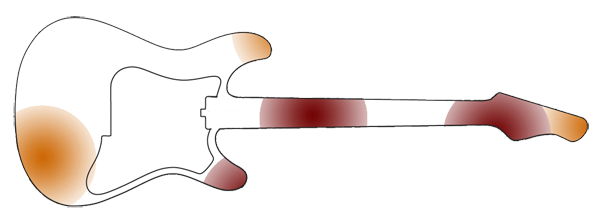
Ex: The Sonnet
As you can see on the picture, both the upper and lower horns produce quite noticeable vibrations. This is one reason why our pickguard does not cover the lower horn, keeping it free to vibrate. The same applies to the headstock and the nut areas. It is particularly obvious that the neck is a sensitive area.
Fig1. Simplified example of measurements made on a Sonnet guitar applying a 400 Hz frequency. Although the whole instrument is virbrating, Red areas show the most important vibrating areas, orange areas show secondary vibrating areas. It is interesting to note that the bridge area's vibrations are absorbed by the bridge itself.
It is clearly evident that on a solid body electric guitar, the neck/nut/headstock area is more mobile than the bridge area.
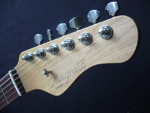
Our research has proven that additional mass in the headstock area can drastically reduce deadspots. You can try this on your guitar by putting a clamp or a capo on the headstock: it will have an effect on the decay of the tone and change the guitar's sound.
Hence, all Magneto necks have a substantial amount of headstock mass (they are slightly thicker at 15mm,) which adds to the overall resonance and evens the response on the entire fingerboard.
Woods
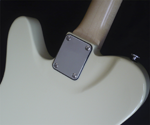
Our tonewoods come from North America, mainly Alder for the bodies and Hard Rock Maple for our necks. The fingerboards are made of East Indian Rosewood.
We use American Alder as the material for our Sonnet and T-Wave guitar bodies. It's a medium-weight wood and provides a resonant, warm, and even sound, with decent sustain and a slightly pronounced upper-midrange.
Hard Rock Maple is a hard, dense wood and generally produces a bright sound. Its stability makes it the ideal wood for necks. Our necks are flat sawn, and we have very good results both in terms of tone and stability.
Indian Rosewood is a smooth grained wood with a wide frequency range. Often used for fingerboards, it softens the high frequencies when used on maple.
We also work on other projects using African Mahogany as wood for body and neck, as well as Ebony for fingerboards.
All woods are specifically chosen and combined to achieve a distinct guitar sound.
The woods we use are naturally seasoned for 5 years before they are shipped to our factory where they usually stay for another year before being used. At this point the moisture content is around 15%, which is not yet good enough for lutherie work, hence we kiln dry to 8% moisture at the factory and then stock it in a dry room prior to use.
Nuts
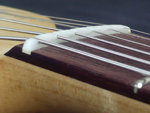
The nuts on our guitars are made of Oiled Cow Bone in order to provide great tone as well as maximum tuning stability.
Neck Profile & Fingerboard Radius
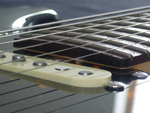
Hardware
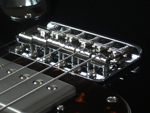
Tuning Gear
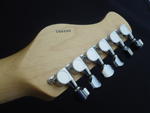
We use die-cast high precision 14:1 ratio tuners made by Gotoh, featuring Gotoh's "Rock-SolidTM" string post system that keeps the posts in perfect position for maximum tuning stabilty. The old regular oil has been replaced with the "Lubri-CoatTM" which is a Solid Lubrication Coat that reduces friction between the gears, resulting in a very smooth feel and longer life for the tuning machine head.
Frets
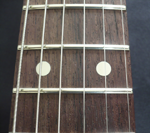
Truss Rod
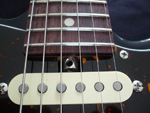
The Magneto necks possess standard single rods. Single truss rods require the removal of less wood from the neck, which we prefer for retaining tone.
The Magneto Quick-Set Truss Rod Nut enables fast and easy setting of the neck relief; this can be achieved between 2 songs!
Pickups & Electronics
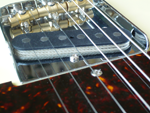
As the combination of the woods and hardware materials has a great influence on the overall tone of the guitars, we design our pickups accordingly, creating the best possible balance. In terms of pickup design, we favor lower-output pickups to obtain better dynamics.
MAGNETO METRO-POLES PICKUP SPECIFICATIONS:
In combination with these, we use the following electronic components:
- CTS (Chicago Telephone Supply) Real Audio Taper Potentiometers with max 10% Tolerance. Still USA made and still the most reliable pots you will find.
- CRL Pickup Switches. USA Made, for years of trouble free operation (25'000 cycles index life!) Made of brass with silver plate and epoxy insulation.
- Switchcraft Output Jacks. The Chicago-based Switchcraft company offers trouble free ouput jacks since 1946. We use nickel-plated copper alloy ¼" phone jacks built for a mechanical life of over 10,000 inserts/withdrawals.
Vintage Style Cloth Wire. AWG 22 solderable copper wire with cotton braid.
All the above components were used in the 1950s/60s and are some of the very few items still available today. We're fortunate and proud to be able to use such high-grade materials.
Shielding
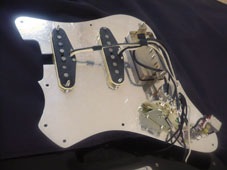
In terms of pickups, we believe in real single coils or humbuckers. In order to create the best possible signal to·noise/hum ratio and hum protection, we protect the cavities in the following way:
·Dottite is painted in the inside cavities. Dottite is a carbon-based conductive coating that ensures the best shielding protection. (Dottite is lead-free and does not use fibers.)
The Magneto Pick-Shield pickguards are designed and custom built by Magneto Guitars.
Composed of either an aluminum or copper plate combined with a polycarbonate base, the Pick-Shield pickguards do not only offer exceptional visual effects, they have originally been conceived as a shield to reduce hum to the max. Both aluminum and copper, best known for their electromagnetic shielding capabilities, will close the pickup cavities and create a so-called Faraday cage.
We place a lot of importance on this extra work as it enables the use of real single-coil pickups without too much hum or any external electro magnetic radiation.
In short, your guitar will be extremely quiet (bearing in mind that putting it 2 inches away from an amp transformer will always create the hum effect.)
For the same reasons, our Aged White pickguards are protected with extra aluminum foil.
Finish
The instrument bodies are finished with a hand rubbed Nitrocellulose Lacquer, the same type as the DUCO automotive lacquer used in the 1960s, or by today's auto restorers. (We mention this because most of today's Nitro finishes are acrylic based, which is slightly different.) The cellulose resin-based lacquer allows us to make a thinner surface, which enables much better resonance. Thickness of the finish is a key issue in our finishing process: a thick coat (being nitro or any other type) will dramatically alter the tone of the woods it is applied on. The total thickness of our finishes does not exceed 0.15-0.18 mm.
For our necks we use a very thin acrylic urethane finish. The neck is the area that the player will touch the most. For this reason, we prefer acrylic urethane for the neck, as it is slightly more consistent and has a pleasing, less sticky feeling than cellulose resin-based finishes.
Temperament, Intonation & Fretwork
Our intruments are designed with respect to the classic guitar tone based on 12-tone equal temperament. At Magneto guitars, we pay particular attention to the intonation of the guitars, and our luthiers are trained to achieve the perfect fret and nut job for perfect intonation. Here again, no computerized step is involved in the whole process except the use of a good tuner.
Chords ring like a bell everywhere on the neck.

